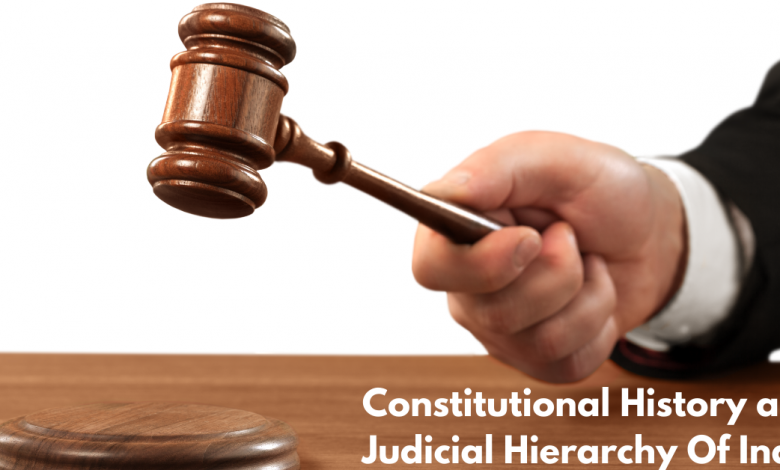Constitutional History and Judicial Hierarchy Of India


India is an Asian country bounded by China, Afghanistan, Pakistan, Bangladesh, and Myanmar. the countries bordering the ocean in the south have the world’s largest population as well as the world’s oldest culture. So it’s no surprise that the history of Indian law and constitution is lengthy. India’s constitutional history, on the other hand, begins after independence. On August 15, 1947, India gained independence from the British crown after a series of nonviolent and violent freedom movements. Which lasted from 1857 until 1947, when the British crown finally accepted that they were finally freeing India. that played an important role in the establishment of the constitutional history and judicial hierarchy of India.
Law in British India: –
The first recorded common law for all in India was introduced by the British East India Company. which was granted by King George First in 1726 to establish “mayor’s courts in Madras, Bombay, Calcutta now became (Chennai, Mumbai, Kolkata) to handle and manage Law in order and substantially expand their jurisdiction area after the victory of Plessey and gradually replace the judiciary system of Mughals.” Even during the critical transition from Mughal to British rule, legal litigators continued to represent their clients in legal proceedings.
Indian constitution after freedom
The first challenge we Indians face after independence is that every country that exists today must have a constitution. A statutory legal body that monitors law and order. So that their country can focus on growth and development. But a good constitution takes time and a lot of effort, as happened with the Indian constitution too. Before that, the Indian judiciary had to follow English rules and regulations for nearly two and a half years. Jawaharlal Nehru the first Indian prime minister, decided to create a constitutional assembly with the responsibility of writing a new constitution for India. Delegated that responsibility to Baba Saheb Ambedkar. a constitutional expert who examined 60+ constitutions from various countries while working with 389 other people (299 after Pakistan’s division). It took three years to complete the Indian constitution draught from scratch..
Judicial Hierarchy in India:-
The Indian judicial system has its own hierarchy to maintain and manage law and order in all regions. Courts are legal bodies that follow the Indian constitution, but in special circumstances, it can also make suggestions to the Indian parliament, such as including some acts or clarifying some of its old acts that are no longer applicable in today’s situations.
Courts in India are divided into three sections.
- Supreme Court: –
- High Court
- District Court
- Special Courts/ Tribunals
Supreme Court: –
The Indian Supreme Court established on January 26, 1950, and is located at Tilak Marg in New Delhi. It is at the top of the judicial hierarchy and deals with important and critical issues in India. It not only deals with civil matters such as law enforcement or resolving disputes between states. The central government. it also monitors the government and points out flaws in government work culture and mistakes. The Supreme Court has the authority to establish a new court for sensitive matters or specific types of cases in the near future or immediately.
High Court: –
At the second level, there are high courts with jurisdiction over one or more states. For example, the Bombay High Court in Mumbai has jurisdiction over the entire state of Maharashtra, but it also includes Goa and the territorial areas of Dadar Nagar Haveli. High courts are typically located in the capital cities of each state. High courts deal with minor judicial matters and monitor law and order. They also highlight how the government is working in terms of welfare, development, and law and order. The high court can overturn any district or other court’s decision, but not the Supreme Court. Currently, India has twenty high courts located throughout the country.
District Court: –
District courts or session courts are the third step. With jurisdiction over single or multiple districts, and deal with all small or large matters, including civil, criminal, and legal disputes. They also keep the law in order at the district level. Currently, India has 672 district courts that report to their respective high courts. Apart from that, we have some other courts that are lower than district courts establish to handle micro issues or matters. Not every estate has this type of court to handle their minor matters locally.
Tribunals or special courts:-
Special courts or tribunals are courts established by the government or the supreme court. the idea is to resolve specific types of matters, such as income tax, central administrative purposes, intellectual property, consumer forums, debts, and recovery, or excise-related solutions. They may be one-time courts or proper tribunals to assist the high court and Supreme Court and ease their workload.
Conclusion: –
India has seen a lot of historical blunder and struggles with its constitutional history and judicial hierarchy so many atrocities punch down India and its people. But with so many efforts and sacrifices. The first recorded common law for all in India was introduced by the British East India Company, which was granted by King George First in 1726 to establish “mayor’s courts in Madras, Bombay, Calcutta now became (Chennai, Mumbai, Kolkata) to handle and manage Law in order and substantially expand their jurisdiction area after the victory of Plessey and gradually replace the judiciary system of Mughals.” Even during the critical transition from Mughal to British rule, legal litigators continued to represent their clients in legal proceedings. High courts deal with minor judicial matters and monitor law and order. Currently, India has twenty high courts located throughout the country.




